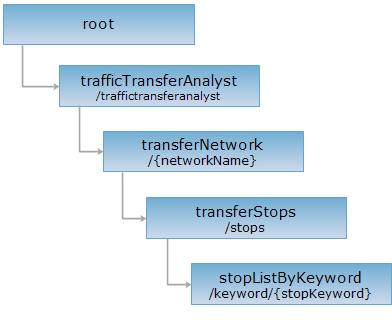URI
<transferNetwork_uri>/keyword/{stopKeyword}[.<format>]
Supported methods
Parent resource
Introduction
Perform bus stop query with the keyword passed in, return the related bus stop.
Supported Methods:
- GET: Get the bus stop whose name is related to the stopKeyword.
- HEAD: Checks whether stopListByKeyword resource exists, or whether it can be accessed.
Supported output formats: rjson, json, html, xml.
GIS Services Resource Hierarchy

HTTP request methods
Implement the HTTP request on the following URI, where supermapiserver is the server name, with rjson being the output format.
http://supermapiserver:8090/iserver/services/traffictransferanalyst-sample/restjsr/traffictransferanalyst/Traffic-Changchun/stops/keyword/人民.rjson
GET request
Get the bus stop whose name is related to the stopKeyword.
Request parameter
| Name | Type | Description |
| returnPosition | boolean | Whether to return the coordinate information of the stop, the default is false. |
Response structure
Return the stop array that meet the condition, the corresponding class of the stop is TransferStopInfo, including the following fields:
| Field | Type | Description |
| alias | String | Stop alias. |
| id | int | Stop ID. |
| name | String | Stop name. |
| position | Point2D | Stop coordinate. |
| stopID | long | Stop ID, corresponding to the stopIDField in the service provider. |
Respose example
Perform GET request on the following address:
http://supermapiserver:8090/iserver/services/traffictransferanalyst-sample/restjsr/traffictransferanalyst/Traffic-Changchun/stops/keyword/人民.rjson?returnPosition=false
The rjson format returned is as follows:
[{
"alias": null,
"id": 164,
"name": "人民广场",
"position": null,
"stopID": 164
}]
HEAD request
Asks for the response identical to the one that would correspond to a GET request, but without the response body. This is useful for retrieving meta-information written in response headers, without having to transport the entire content. The meta-information includes the media-type, content-encoding, transfer-encoding, content-length, etc.
HEAD request can be used to check if the keyword resource exists, or if the resource can be accessed by clients. It can also determine if the keyword resource supports an output format <format> if performed on a URI with .<format> included.